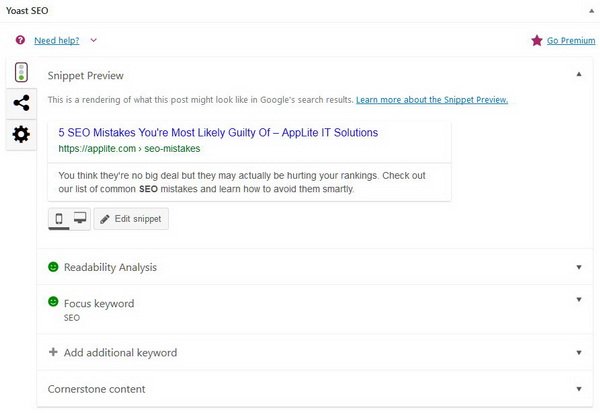You think they’re no big deal but they may actually be hurting your rankings. Check out our list of common SEO mistakes and learn how to avoid them.

Messing it up with the lack of (or overuse) SEO keywords
Writing without mindfully incorporating SEO keywords could be decrease the ranking and conversion potential of your website. Remember, you are not just creating exciting content to attract your target audience but Google spider as well, the god of Internet who decides if you’re worthy to be shown on the first page of the searches.
Putting keywords into your blogs or articles just for the sake of playing by the rules is not enough. You have to do it correctly if you want results. Doing your due diligence in researching competitive keywords within your niche is definitely worth it. Take note of Use helpful keyword research tools to explore this area. There are several free options out there, such as Google Ads Keyword Planner, Soovle, and WordStream Free Keyword Tool.
For good measure, make sure you have your important keywords in the following areas:
- Blog title
- Meta description
- Page URL
- Once in subheadings
- Once or twice in the body of your article
There is no need to overdo this and overpopulate write-ups with keywords. Gone are the days of robotic writing and excessive keyword repetition. Google’s AI is smarter everyday, so don’t even think about it. Plus, this could also be a major turn off for your readers.
Forgetting about on-page optimization

Another crucial but unfortunately frequently neglected SEO best practice is on-page optimization. This is not rocket science. It simply involves providing content in these key areas:
- SEO title
- URL
- Meta description
- Image names and alt tags
It’s known that Google search engine crawls and puts weight on these things. Next time you’re publishing a blog, releasing new product collection, or have the luxury of time in your hands, do yourself a favor and enable your website’s on-page optimization. Trust us, it’s one of the little things you can do to increase the success of your rankings.
A sluggish website
This day and age of the Internet has made us more impatient than ever and our attention span is poorer than it ever was. No one waits for a slow-loading website, especially not when there’s a competitor with the same product or content at lightning speed. It’s also worth noting that Google takes note of your website’s speed.

Be proactive and check your website’s performance using these free tools:
- GTmetrix – https://gtmetrix.com/
- Page Speed Insights – https://developers.google.com/speed/pagespeed/insights/
- Test My Site – Think with Google – https://testmysite.thinkwithgoogle.com/
- Pingdom Tools – https://tools.pingdom.com/
AppLite has an article about speed optimizations you can make for your site – Technical SEO – The Server-Side Optimizations
Uninformed use of links
Link building is a powerful way to drive traffic to your website and leverage against your competitors. But there is a way for this strategy to work against you and shoo away your readers.
- Too many outbound links – As a rule of thumb, limit outbound links to two to five per every 1,000-word article.
- Dedicating important keywords and long-tail keywords (which catch readers’ attention) to outbound links.
- Links opening to same window instead of a new one. Inspect links in previously written articles and make sure they open to a new window. Usually, CRMs, such as Shopify, show on your dashboard which articles are bouncing. Keep outbound links in the second and last paragraph.
- Links to unreputable sites. Outbound link only to credible websites, such as scientific publications, journals, or whatever is deemed an authority site for your niche (Buzzfeed, Vox, Martha Stewart, etc.) stay away from spammy, possibly fake news websites. Google is cracking down on these types of sites, and if you’re not careful, you could be found guilty by association.
- Not doing inbound links. Doing so piques your reader’s interest to another article or perhaps a product they might like. Season well-written articles with at least five inbound links, with most of it strategically located in the upper part of the article.
A site that is not mobile-ready
 With people always on the go and the rise of more powerful smartphones, it’s no surprise that most people are checking their favorite websites and social media platforms through their phones.
With people always on the go and the rise of more powerful smartphones, it’s no surprise that most people are checking their favorite websites and social media platforms through their phones.
As a matter of fact, recent data reveals that:
- In 2018, 52.2 percent of all website traffic produced worldwide was through mobile phones (Statista 2018).
- A whopping 61.9 percent of paid-search clicks in Google were all generated by consumers on their smartphones.
- In the second quarter of 2017, Facebook reported earning $9.16 billion in advertising revenue of through mobile users, which was a 47 percent increase over the same quarter from the previous year.
If mobile optimization is not one of your top priorities, you can forget about your rankings because you’re not going to get there. Google pushes non-mobile-ready websites to the last pages of the search results. And let’s be honest, who bothers after page 2, right?
Screenshot within the Google Ads dashboard, showing the vast majority of usage from mobile devices.

There are loads of other things you can do if you want bring your a-game with SEO and content marketing. We’d love to help you achieve that, connect with us today.
By: Arrianne del Rosario, Independent Writer for AppLite, LLC.

